|
|
lavender ni ada bau ka dak...
tetiba teringat novel Kasih Seharum Lavender...
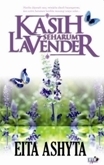
[ Last edited by Mas916 at 24-7-2008 09:06 AM ] |
|
|
|
|
|
|
|
|
|
|
|
Balas #2 Mas916\ catat
mmg bau mas.... mcm perfume lavender... |
|
|
|
|
|
|
|
|
|
|
|

Mitchem Gray namanya...mcm serupa je dgn cikna punye..
20" English lavender, medium size, deep purple flowers, grey foliage
credit to Purple Haze |
Rate
-
1
View Rating Log
-
|
|
|
|
|
|
|
|
|
|
|
|
I suka bau Lavender...calming...I selalu bedakkan baby I Baby Johnson Lavender selepas dia mandi utk menidurkan dia...esp mandi petang. Even mandi malam I guna Mandian Buih May Lavender nak bagi senang tidur... |
Rate
-
1
View Rating Log
-
|
|
|
|
|
|
|
|
|
|
|
Reply #1 cikna99's post
cikna..amek kt mn pokok nih???beli ka???cm sng ja nk tnm dia..klu bau dia kuat best gak..harum jek bau kt umah..  |
|
|
|
|
|
|
|
|
|
|
|
Reply #1 cikna99's post
eee...cik naaa, cantiknyer..pokok ni jenis pokok renek ke ?
mana dapat benihnya? macam best je kan.....  |
|
|
|
|
|
|
|
|
|
|
|
racun lavender dah mula merebak nampak nyer...  |
|
|
|
|
|
|
|
|
|
|
|
Info Lavender....
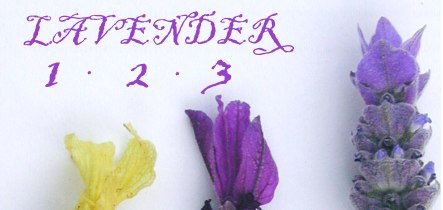
THE NON-ENGLISH LAVENDERS
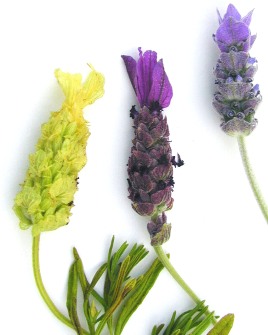
From left to right: Yellow Lavender, Spanish Lavender
and French Lavender
Spanish Lavender, with its dark purple, pineapple-shaped flower heads and dark green leaves, looks great planted with Orchid Rockrose and Golden Garden Sage. It grows low and wide and may layer its stems, allowing one plant to cover a lot of ground. It can also be pruned off the ground and shaped for a topiary effect.
Spanish Lavender is sometimes referred to as French Lavender. Since it grows wild in France, this is understandable. It is collected there to some extent and processed for oil used in perfume.
Yellow Lavender also has a pineapple-shaped flower head but the colorful top bracts are a lemon chiffon color. The yellow-green leaves are pungently scented and their color makes them a good foil for gray Lavenders. Since this Lavender grows tall and wide, it can be planted at the back of a row of Lavandula angustifolias or L. x intermedias.
Sweet Lavender is Lavender in the extreme. The greenest leaves, the greatest size, the fastest growth, and the longest flower wands are all great reasons for having this Lavender in the garden. Plant a large triangle of Sweet Lavender in the middle of a garden and surround it with Chocolate Scented Daisies for a visual and fragrant impact.
French Lavender has the more traditional gray leaves but with serrated edges. A large, fast growing shrub that is sometimes referred to as everblooming Lavender, French Lavender does best when kept at no more than three feet, including blooms. The large, blocky flower heads can be dried if picked before any of the little flowers turn brown.
Allardi Lavender is a form of French Lavender that is thought to be crossed with Lavandula latifolia, Spike Lavender, with a bit less rangy growth habit than French.
Goodwin Creek Gray Lavender is a hybrid of French Lavender with a shorter growth habit and a darker purple flower head that is held on a longer wand. It makes a nice border or edging plant.
Woolly Lavender likes it dry. The gray foliage and dark purple flowers are spectacular and come on in the heat of summer when all the other Lavenders are waning. Plant this near the path to the house to refresh you during the hottest time of year.
THE ENGLISH LAVENDERS
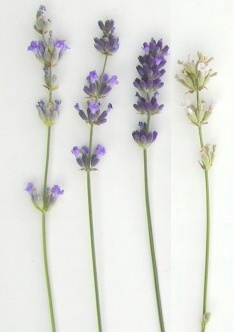
From left to right: Vera, Munstead, Hidcote, Jean Davis
The English Lavenders (Lavandula angustifolias), include English, Munstead, Hidcote, Hidcote Pink, Jean Davis, Sarah, and Vera and flower in mid to late spring. These second-round bloomers are finished by late spring or early summer. These look great when they flower, and, after pruning, remain a compact ball or hedge with exotically fragrant leaves the rest of the year. These Lavenders are hardy to Zone 5 but, like all Lavenders, will not tolerate poor drainage or high humidity.
English Lavender is large leaved and tall. It has been in our nursery for more than 15 years. It grows robustly and has great color and fragrance. Even though it is unusual for an English Lavender to be this large, this plant has pollen, and blooms at the same time as the other Lavandula angustifolias.
Munstead Lavender is named for Munstead Woods, the home of famous garden designer Gertrude Jekyll. Tolerating summer heat the best of all of the above English Lavenders, Munstead Lavender looks great planted with Yellow or White Roses.
Hidcote Lavender is famous for its dark purple flower. Smaller than Munstead, it likes a cooler climate than our semi-arid summer can provide and we consistently have problems with it dying during hot months. Like most of these 'English' Lavenders, Hidcote is not as drought or heat tolerant as the Lavandins.
Hidcote Pink Lavender has a pastel pink flower spike that looks best planted in mass and viewed at a bit of a distance rather than up close.
Jean Davis Lavender also has a pastel pink flower. Looking at Hidcote Pink and Jean Davis together, it is hard to tell them apart. The difference, oddly enough, is in the taste. A fruity-flavored flower sets Jean Davis apart from other Lavenders. Munstead is a close second. Unfortunately, Jean Davis is harder to grow than Munstead, which is why Munstead was chosen instead as an addition to our Edible Flower Herb Garden Six Pack.
Sarah Lavender is one of many lesser-known L. angustifolias. A very small plant with short flower spikes and small, yet showy dark purple flowers; it is very suited to window boxes and container growing.
Vera Lavender or Lavender Vera is thought to be the true English Lavender. Also called True Lavender or Fine Lavender, the best quality oil comes from plants grown at altitudes between 2500 and 4500 feet on the sides of mountains in central Europe. It is thought to be the best Lavender for medicinal and aromatherapy purposes.
THE LAVANDINS
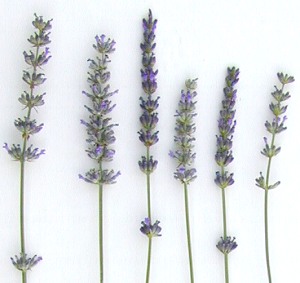
From left to right: Grappenhall, Provence, Grosso,
Dutch Mill, Abrialii and Seal
The English Lavender Hybrids, sometimes referred to as Lavandins; come in third in the bloom cycle, starting just as the the English Lavenders are finishing, and continuing to mid summer.
These are the workhorses of Lavender. They do it all: bloom lots, grow just the right size, and smell like a million bucks. Provence and Grosso are the best known of these, but there are many others, including Abriali, Fred Boutin, Dutch Mill, Grappenhall, Seal, Hidcote Giant and White Grosso. These are the ones to line the drive or border the garden with.
The botanical name for the Lavandins is Lavandula x intermedia. The x means it is a cross with two plants and we know which two. In this case, it is L. angustifolia and L. latifolia. The intermedia means that these crossed plants have qualities of both parents, or it is intermediate between them.
Lavandins have long gray leaves, twice or more the size of L. angustifolias. They also grow much larger and faster.
Abriali Lavender is one of the older Lavandins. Also beautifully colored, it is a little shorter than Grosso and was used for oil production before Grosso was developed.
Dutch Mill Lavender has vibrant grape colored flowers that stand out well against darker flowered lavenders like Grosso. Because it is a lighter shade, it shows up better in very sunny situations.
Fred Boutin Lavender, discovered in 1980, is a long-stemmed beauty with a medium purple flower. It has very silvery leaves and excellent fragrance.
Grosso Lavender is cultivated for oil used mainly in the cosmetic industry. It makes great Lavender bouquets and wands. Grosso Lavender has beautiful purple calyxes instead of the normal green calyx of most lavenders.
White Grosso Lavender is a must have for the garden and for the vase. Its swan white blooms complement the purples of other lavenders and they stay white when dried.
Grappenhall Lavender is a tall, long-leaved Lavender with a slender bloom and a medium purple flower. Because the leaves are longer this plant has the energy to grow quickly and in larger proportions.
Hidcote Giant Lavender has dark purple flowers that are close together. It is a striking plant in the landscape.
Provence Lavender has a long, slender flower wand that is useful for dried bud collecting. The buds come cleanly and easily away from the stalk.
Seal Lavender is a highly fragrant bright purple old time favorite that is perfect for crafts or hedges.
Any way you look at them, lavenders are luscious long stemmed, aromatic necessities.
Credit to Mountain Valley Growers |
Rate
-
1
View Rating Log
-
|
|
|
|
|
|
|
|
|
|
|
How to Grow Lavender!
Instructions
Difficulty: Moderately Easy
Step1
Picking your plants!
The Lavender plants you pick depend on your climate. English Lavender, (Lavandula angustifolia), is the most hardy plant and grown the most widely. It is easy to mix in a perennial bed. This plant will endure subzero winters, but dislikes humid heat. If you live in a humid climate look for a LavanDIN instead of lavender. "Grosso and Provence" are the best lavandins. You can even chose your hue of lavender, but unless you get shoots from a "mother" plant, you will not have a consistent color or flower.
Step2
Picking your spot to plant!
The most important factor about Lavender is drainage. Soggy areas should definitely be avoided. Incorporate organic matter if necessary to make a loose soil for easy drainage.
Lavender prefers a sloping bed in a sunny spot. A solution to that would be to heap soil in a pile about 12 to 18 inches high before planting the lavender. If your soil is mostly clay soil, dig out your hole and mix the clay with sand. Lavender plants cannot compete with aggressive weeds, so ensure your chosen spot is weed free. This is most important if you are planting a hedge of lavender, as weeding after they are planted can be a huge hassle. Weeding often becomes such a chore that Lavenders are overrun and eventually dies in a neglected hedge.
Step3
Planting:
When planting lavender place the plants at least 2 feet apart. Start with 4-inch-pot sized plants. Leave plenty of room between plants for air circulation. If planting in pots, make sure to repot every spring into a larger container with fresh soil to allow the plant to continue to mature. A good, coarse, sterile potting soil with organic fertilizers works best.
Step4
Watering:
Lavender does not like overhead sprinkler and could rot if they get too much water. Use a drip irrigation and water only when the bed is dry to a depth of 3 or 4 inches. While Lavender is extremely drought resistant once established, it grows larger and produces more blooms with regular watering. It is important to let the plant dry out a bit before soaking it again. In humid areas, this can be difficult and the excess moisture often causes death by rotting. Do not mulch lavender! It holds too m uch moisture.
Step5
Fertilizer:
Wait about two years to fertilize the plants and then use an organic product such as fish emulsion. Feed the plants in spring when they start growing and again after harvesting in late summer. If you grow plants as annuals, you don't have to feed them at all.
Step6
Pruning and Harvesting:
It takes about three years for Lavender to reach full size. Plants should be pruned every year immediately after bloom. Pruning should not be confused with harvesting. Pruning is necessary to extend the life of the plant because lavender gets very woody if not pruned. Lavender flower wand stems are a bright green and Lavender leaves are gray. Cut back not only the flower stem, but also about a third of the gray-leaved stems as well. Avoid pruning back so far that only woody stems with no leaves are showing as it may die.
Harvest the flowers according to end use. For a fresh bouquet pick when the flowers are in full bloom and scent. For dried bundles the stem must be harvested before the florets completely open. If you wait until the flower is open it will fall apart when they are dried. Take a handful of stems and cut them off at the base of the plant and then wrap rubber bands around them. To dry them hang them upside down. Drying takes about two weeks, but keep good circulation around your bundles to avoid them falling part or rotting. Harvesting the lavender for oil must be done at the peak of the day's heat. Essential oil can be extracted by steam distillation from the fresh flowers. |
Rate
-
1
View Rating Log
-
|
|
|
|
|
|
|
|
|
|
|
Bolehlah Cikna buat mandian sendiri nanti menggunakan lavender yg ditanam.... |
|
|
|
|
|
|
|
|
|
|
|
Reply #9 cikna99's post
|
emm.. kalau senang nak mjaganyer n berbau harum pula ..blh cuba jg nie.... |
|
|
|
|
|
|
|
|
|
|
|
Reply #9 cikna99's post
if u dont mind..brape reganya pokok tu yg makcik tu bg dkt cikna???klu murah nk gak try..  |
|
|
|
|
|
|
|
|
|
|
|
Originally posted by Rizyani at 23-7-2008 03:45 PM 
I suka bau Lavender...calming...I selalu bedakkan baby I Baby Johnson Lavender selepas dia mandi utk menidurkan dia...esp mandi petang. Even mandi malam I guna Mandian Buih May Lavender nak bagi ...
jangan kata baby....org dewasa pun pakai mandian lavender tu hehehe |
|
|
|
|
|
|
|
|
|
|
|
baru perasan.. lavender ni ade kt tmn sek. |
|
|
|
|
|
|
|
|
|
|
|
Balas #17 mizahanan\ catat
cikna...
mcm senang jer tanam lavender ni...main cucuk je ek....??bley try ni |
|
|
|
|
|
|
|
|
|
|
|
Reply #19 cikna99's post
cikna...kita ni agaknnye dok dekat2 jer ek....
kejariah kt dia pon dok bangi...dekat ngan cikna...kat mana agaknyer tu |
|
|
|
|
|
|
|
|
|
| |
|